Analysis of Human Body Shadowing Effect on Wireless Sensor Networks Operating in the 2.4 GHz Band
Abstract
1. Introduction
2. Materials and Methods
2.1. Analysis of Shadowing Effect with Finite-Difference Time-Domain Based Program
2.2. Human Body Model for Shadowing Analysis in UTD-Based Program
3. Results
3.1. Analysis of Human Body Shadowing in an Indoor Environment Using XGtd™
3.2. Measurements of Human Body Shadowing in the Indoor Environment
4. Discussion
5. Conclusions
Funding
Conflicts of Interest
References
- Ruiz-Garcia, L.; Lunadei, L.; Barreiro, P.; Robla, I. A Review of Wireless Sensor Technologies and Applications in Agriculture and Food Industry: State of the Art and Current Trends. Sensors 2009, 9, 4728–4750. [Google Scholar] [CrossRef] [PubMed]
- Xu, G.; Shen, W.; Wang, X. Applications of Wireless Sensor Networks in Marine Environment Monitoring: A Survey. Sensors 2014, 14, 16932–16954. [Google Scholar] [CrossRef] [PubMed]
- Aquino-Santos, R.; Martinez-Castro, D.; Edwards-Block, A.; Murillo-Piedrahita, A.F. Wireless Sensor Networks for Ambient Assisted Living. Sensors 2013, 13, 16384–16405. [Google Scholar] [CrossRef] [PubMed]
- Silva, I.; Guedes, L.A.; Portugal, P.; Vasques, F. Reliability and Availability Evaluation of Wireless Sensor Networks for Industrial Applications. Sensors 2012, 12, 806–838. [Google Scholar] [CrossRef] [PubMed]
- Egbogah, E.E.; Fapojuwo, A.O. A Survey of System Architecture Requirements for Health Care-Based Wireless Sensor Networks. Sensors 2011, 11, 4875–4898. [Google Scholar] [CrossRef] [PubMed]
- Aponte-Luis, J.; Gómez-Galán, J.A.; Gómez-Bravo, F.; Sánchez-Raya, M.; Alcina-Espigado, J.; Teixido-Rovira, P.M. An Efficient Wireless Sensor Network for Industrial Monitoring and Control. Sensors 2018, 18, 182. [Google Scholar] [CrossRef] [PubMed]
- Cheung, W.-F.; Lin, T.-H.; Lin, Y.-C. A Real-Time Construction Safety Monitoring System for Hazardous Gas Integrating Wireless Sensor Network and Building Information Modeling Technologies. Sensors 2018, 18, 436. [Google Scholar] [CrossRef] [PubMed]
- Buratti, C.; Conti, A.; Dardari, D.; Verdone, R. An Overview on Wireless Sensor Networks Technology and Evolution. Sensors 2009, 9, 6869–6896. [Google Scholar] [CrossRef] [PubMed]
- Knight, C.; Davidson, J.; Behrens, S. Energy Options for Wireless Sensor Nodes. Sensors 2008, 8, 8037–8066. [Google Scholar] [CrossRef] [PubMed]
- Dâmaso, A.; Freitas, D.; Rosa, N.; Silva, B.; Maciel, P. Evaluating the Power Consumption of Wireless Sensor Network Applications Using Models. Sensors 2013, 13, 3473–3500. [Google Scholar] [CrossRef] [PubMed]
- Mojaiana, S. Impacts of Human Body Shadowing in Wireless Body-Centric Communications. Int. J. Future Gener. Commun. Netw. 2016, 9, 191–200. [Google Scholar] [CrossRef]
- Wang, Y.; Bonev, I.B.; Nielsen, J.O.; Kovacs, I.Z.; Pedersen, G.F. Characterization of the Indoor Multi-Antenna Body-to-Body Radio Channel. IEEE Trans. Antennas Propag. 2009, 57, 972–979. [Google Scholar] [CrossRef]
- Queiroz, A.D.C.; Trintinália, L.C. An analysis of human body shadowing models for ray-tracing radio channel characterization. In Proceedings of the SBMO/IEEE MTT-S International Microwave and Optoelectronics Conference (IMOC), Porto de Galinhas, Brazil, 3–6 November 2015; pp. 1–5. [Google Scholar]
- Cotton, S.L. Human Body Shadowing in Cellular Device-to-Device Communications: Channel Modeling Using the Shadowed kappa-mu Fading Model. IEEE J. Sel. Areas Commun. 2015, 33, 111–119. [Google Scholar] [CrossRef]
- Peter, M.; Wisotzki, M.; Raceala-Motoc, M.; Keusgen, W.; Felbecker, R.; Jacob, M.; Priebe, S.; Kürner, T. Analyzing human body shadowing at 60 GHz: Systematic wideband MIMO measurements and modeling approaches. In Proceedings of the 6th European Conference on Antennas and Propagation (EUCAP), Prague, Czech Republic, 26–30 March 2012; pp. 468–472. [Google Scholar]
- Gustafson, C.; Tufvesson, F. Characterization of 60 GHz Shadowing by Human Bodies and Simple Phantoms. Radioengineering 2012, 12, 979–984. [Google Scholar]
- Akimoto, K.; Kameda, S.; Motoyoshi, M.; Suematsu, N. Measurement of human body blocking at 60 GHz for inter-network interference of mmWave WBAN. In Proceedings of the 2017 IEEE Asia Pacific Microwave Conference (APMC), Kuala Lumpar, Malaysia, 13–16 November 2017; pp. 472–475. [Google Scholar]
- Chen, X.; Tian, L.; Tang, P.; Zhang, J. Modelling of Human Body Shadowing Based on 28 GHz Indoor Measurement Results. In Proceedings of the 2016 IEEE 84th Vehicular Technology Conference (VTC-Fall), Montreal, QC, Canada, 18–21 September 2016; pp. 1–5. [Google Scholar]
- Jung, J.H.; Lee, J.; Lee, J.H.; Kim, Y.H.; Kim, S.C. Ray-Tracing-Aided Modeling of User-Shadowing Effects in Indoor Wireless Channels. IEEE Trans. Antennas Propag. 2014, 62, 3412–3416. [Google Scholar] [CrossRef]
- Zhao, Y.; Hao, Y.; Alomainy, A.; Parini, C. UWB on-body radio channel modeling using ray theory and subband FDTD method. IEEE Trans. Microw. Theory Tech. 2006, 54, 1827–1835. [Google Scholar] [CrossRef]
- Cotton, S.L.; McKernan, A.; Ali, A.J.; Scanlon, W.G. An experimental study on the impact of human body shadowing in off-body communications channels at 2.45 GHz. In Proceedings of the 5th European Conference on Antennas and Propagation (EUCAP), Rome, Italy, 11–15 April 2011; pp. 3133–3137. [Google Scholar]
- Cotton, S.L. A Statistical Model for Shadowed Body-Centric Communications Channels: Theory and Validation. IEEE Trans. Antennas Propag. 2014, 62, 1416–1424. [Google Scholar] [CrossRef]
- Van Torre, P.; Vallozzi, L.; Jacobs, L.; Rogier, H.; Moeneclaey, M.; Verhaevert, J. Characterization of Measured Indoor Off-Body MIMO Channels with Correlated Fading, Correlated Shadowing and Constant Path Loss. IEEE Trans. Wirel. Commun. 2012, 11, 712–721. [Google Scholar] [CrossRef]
- Van Torre, P.; Vanveerdeghem, P.; Rogier, H. Correlated shadowing and fading characterization of MIMO off-body channels by means of multiple autonomous on-body nodes. In Proceedings of the 8th European Conference on Antennas and Propagation (EuCAP 2014), The Hague, The Netherlands, 6–11 April 2014; pp. 844–848. [Google Scholar] [CrossRef]
- Januszkiewicz, Ł. Model for Ray-Based UTD Simulations of the Human Body Shadowing Effect in 5G Wireless Systems. Int. J. Antennas Propag. 2018, 2018, 9084830. [Google Scholar] [CrossRef]
- Taflove, A.; Hagness, S.C. Computational Electrodynamics: The Finite-Difference Time-Domain Method; Artech House: Norwood, MA, USA, 2005; ISBN 978-1580538329. [Google Scholar]
- Kunz, K.S.; Luebbers, R.J. The Finite-Difference Time-Domain Method for Electromagnetics; CRC Press: Boca Raton, FL, USA, 1993; ISBN 978-0849386572. [Google Scholar]
- Remcom Inc. XFDTD Reference Manual, Release 7.6.0; Remcom Inc.: State College, PA, USA, 2016. [Google Scholar]
- Yee, K. Numerical solution of initial boundary value problems involving maxwell’s equations in isotropic media. IEEE Trans. Antennas Propag. 1966, 14, 302–307. [Google Scholar]
- IEEE Recommended Practice for Measurements and Computations of Radio Frequency Electromagnetic Fields with Respect to Human Exposure to Such Fields,100 kHz–300 GHz; IEEE Std C95.3-2002 (Revision of IEEE Std C95.3-1991); IEEE: New York City, NY, USA, 2002. [CrossRef]
- Andreuccetti, D.; Fossi, R.; Petrucci, C. An Internet Resource for the Calculation of the Dielectric Properties of Body Tissues in the Frequency Range 10 Hz–100 GHz; IFAC-CNR: Florence, Italy, 1997; Available online: http://niremf.ifac.cnr.it/tissprop/ (accessed on 20 August 2018).
- Watanabe, K.S.; Yamanaka, Y.; Asou, H.; Ishi, Y.; Sato, K. Dielectric properties of liquid phantoms for evaluations of mobile phones. In Proceedings of the EMC’04, Sendai, Japan, 1–4 June 2004; 4B3-5. pp. 805–808. [Google Scholar]
- Saez de Adana, F.; Gutierrez, O. Practical Applications of Asymptotic Techniques in Electromagnetics; Artech House: Norwood, MA, USA, 2010; ISBN 978-1608070633. [Google Scholar]
- Macnamara, T. Introduction to Antenna Placement and Installation; John Wiley & Sons, Incorporated: Hoboken, NJ, USA, 2010; ISBN 978-0-470-01981-8. [Google Scholar]
- Remcom Inc. XGtd Reference Manual, Version 3.1.2; Remcom Inc.: State College, PA, USA, 2017. [Google Scholar]
- Pathak, P.H.; Burnside, W.D.; Marhefka, R.J. A uniform gtd analysis of the diffraction of electromagnetic waves by a smooth convex surface. IEEE Trans. Antennas Propag. 1980, 28, 631–642. [Google Scholar] [CrossRef]
- Pathak, P.H.; Wang, N.; Burnside, W.D.; Kouyoumijian, R.G. A uniform GTD solution for the radiation from sources on a convex surface. IEEE Trans. Antennas Propag. 1981, 29, 609–622. [Google Scholar] [CrossRef]
- Kouyoumjian, R.G.; Pathak, P.H. A uniform geometrical theory of diffraction for an edge in a perfectly conducting surface. Proc. IEEE 1974, 62, 1448–1461. [Google Scholar] [CrossRef]
- Januszkiewicz, Ł.; Hausman, S. Simplified human phantoms for wireless body area network modelling. In Proceedings of the 2015 9th European Conference on Antennas and Propagation (EuCAP), Lisbon, Portugal, 13–17 April 2015; pp. 1–4. [Google Scholar]
- Januszkiewicz, L. Simplified human body models for interference analysis in the cognitive radio for medical body area networks. In Proceedings of the 2014 8th International Symposium on Medical Information and Communication Technology (ISMICT), Firenze, Italy, 2–4 April 2014; pp. 1–5. [Google Scholar]
- Januszkiewicz, Ł.; Di Barba, P.; Hausman, S. Field-Based Optimal Placement of Antennas for Body-Worn Wireless Sensors. Sensors 2016, 16, 713. [Google Scholar] [CrossRef] [PubMed]
- Hausman, S.; Januszkiewicz, Ł. Impact of Indoor Environment on Path Loss in Body Area Networks. Sensors 2014, 14, 19551–19560. [Google Scholar] [CrossRef] [PubMed]
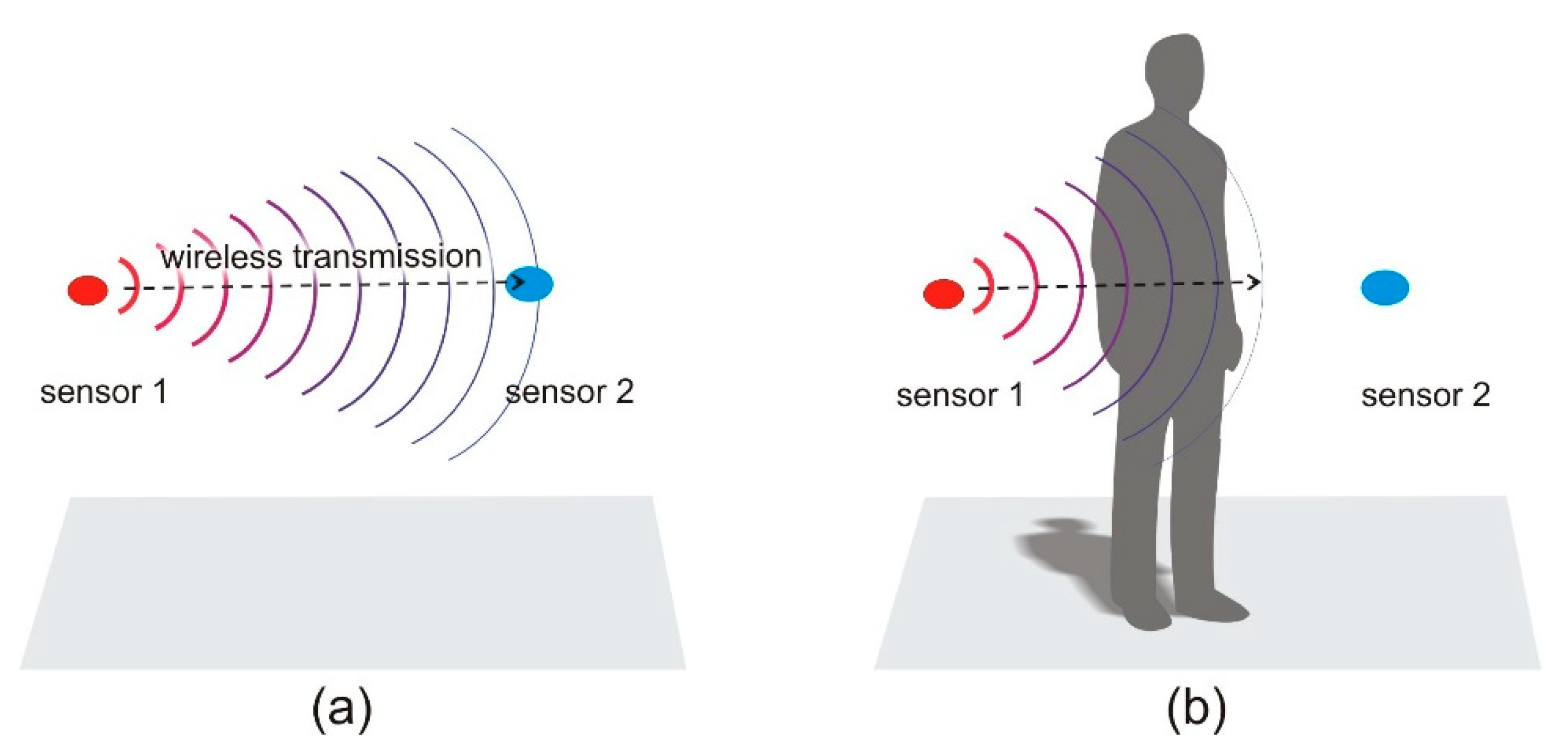

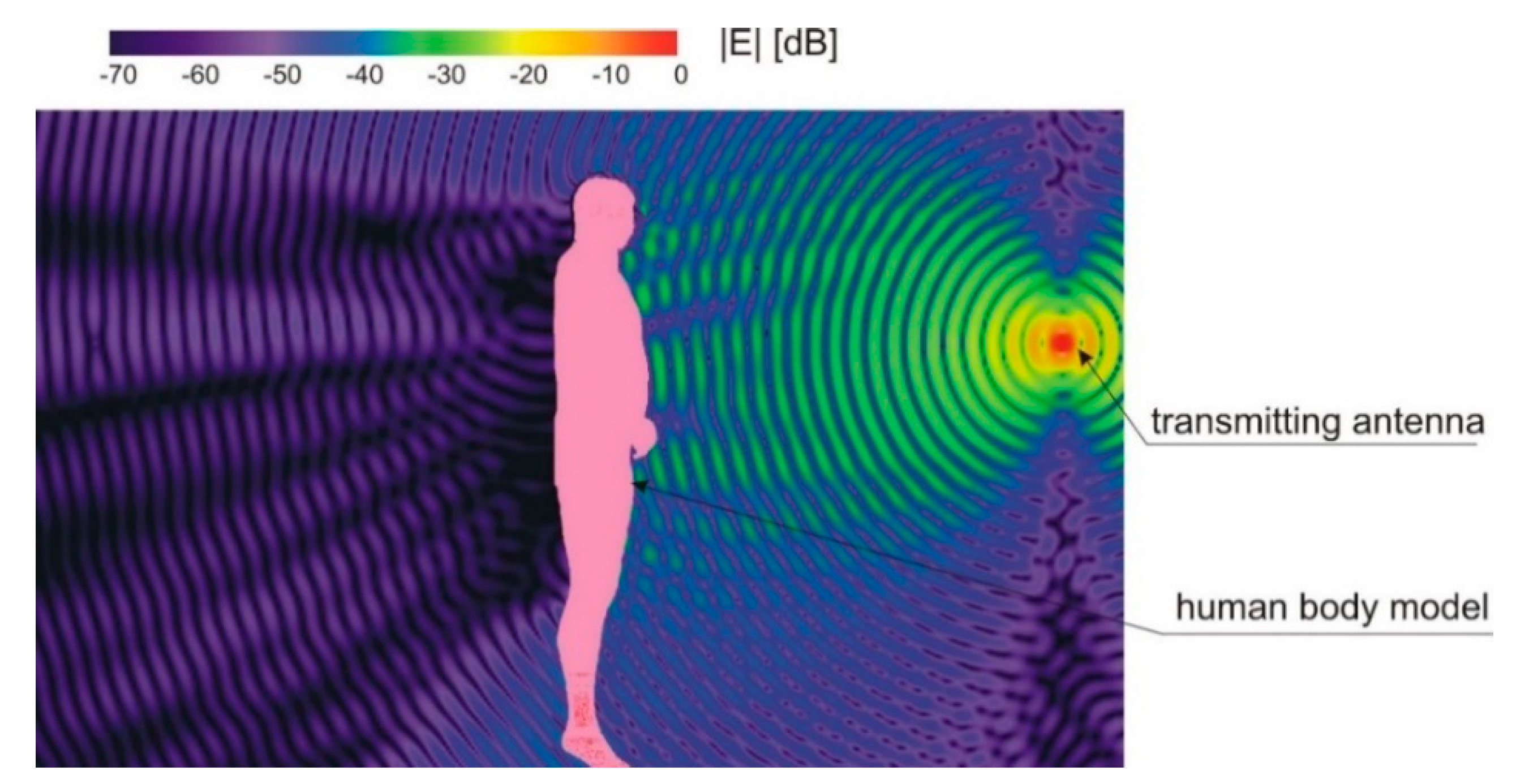
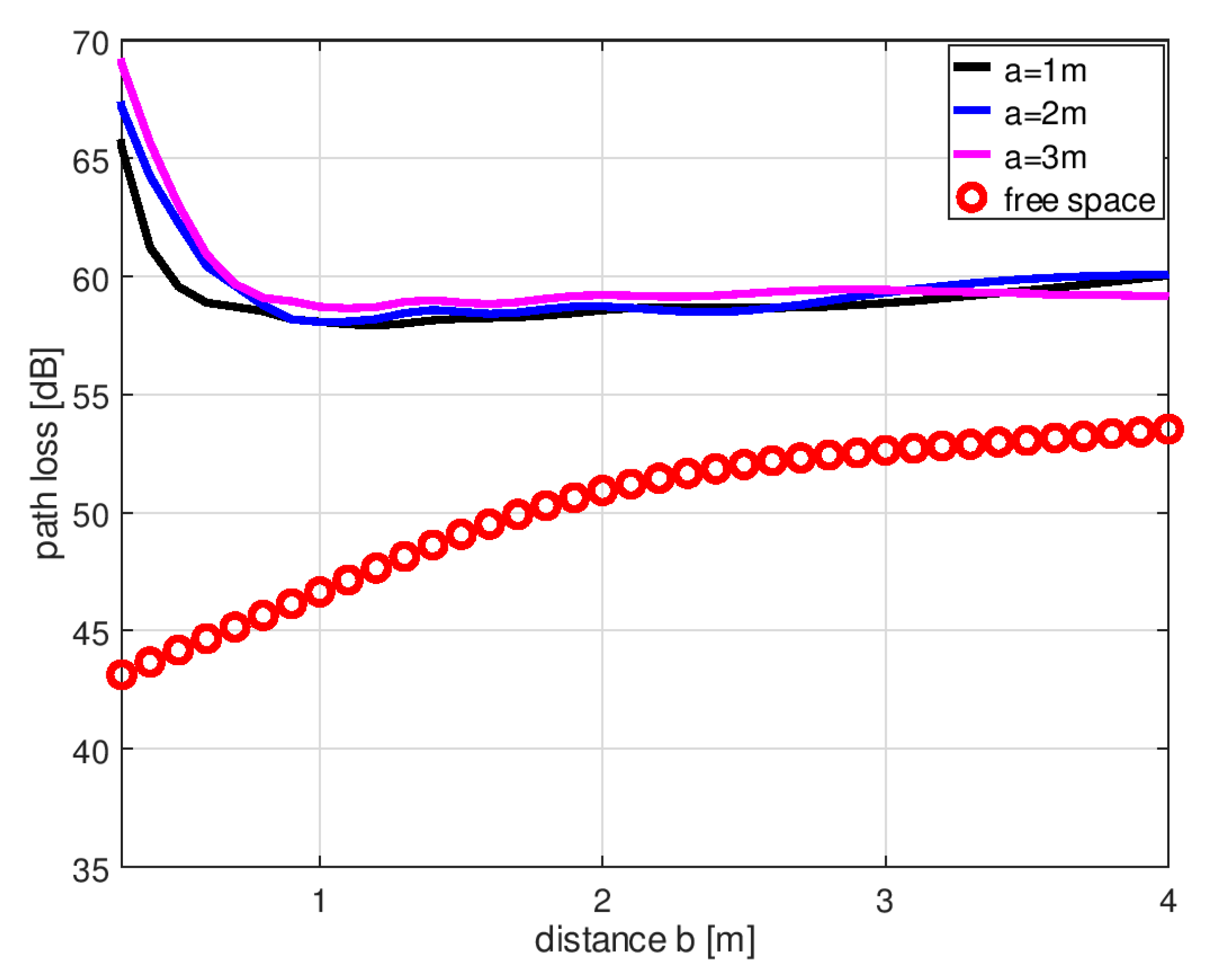
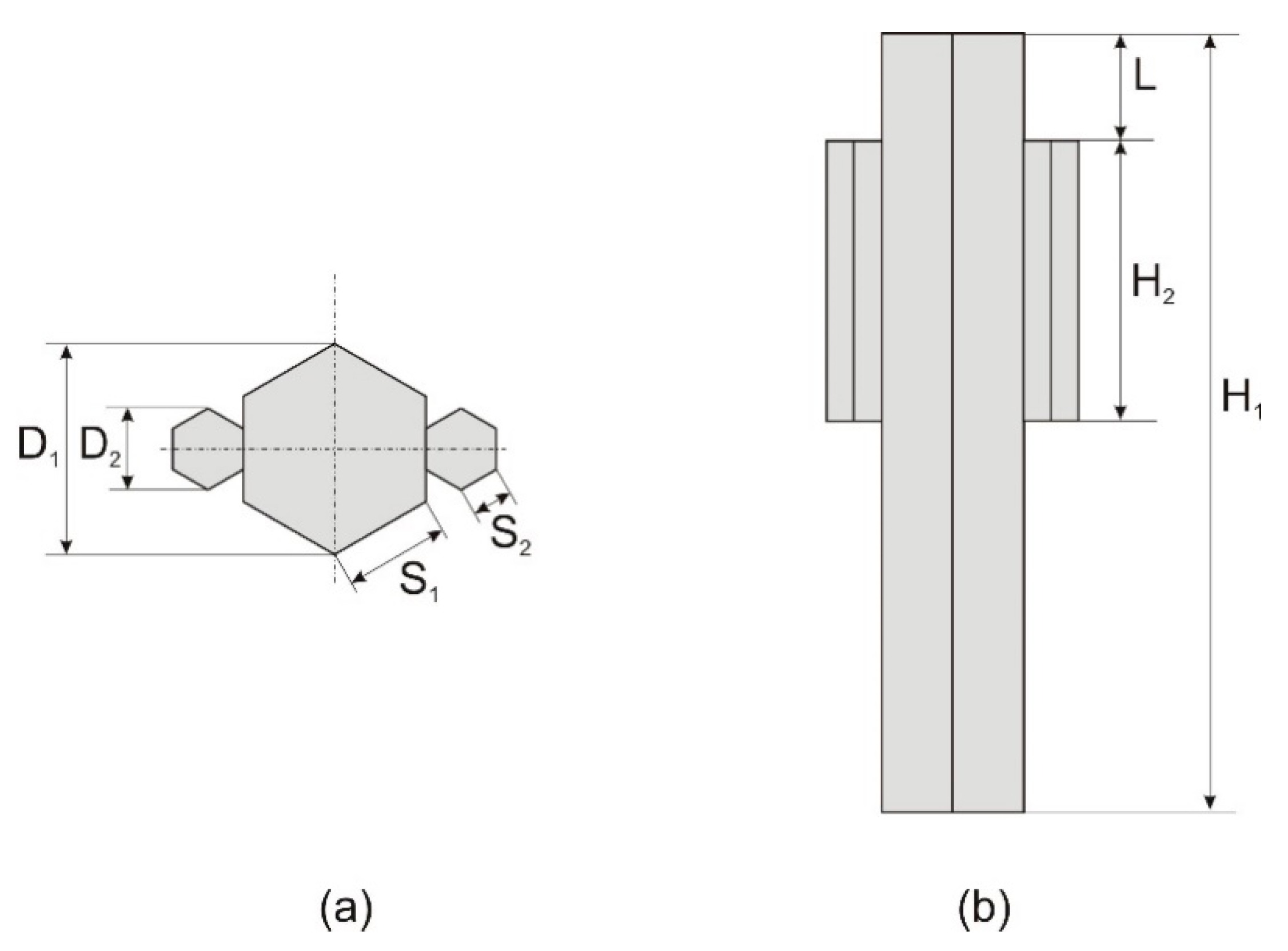
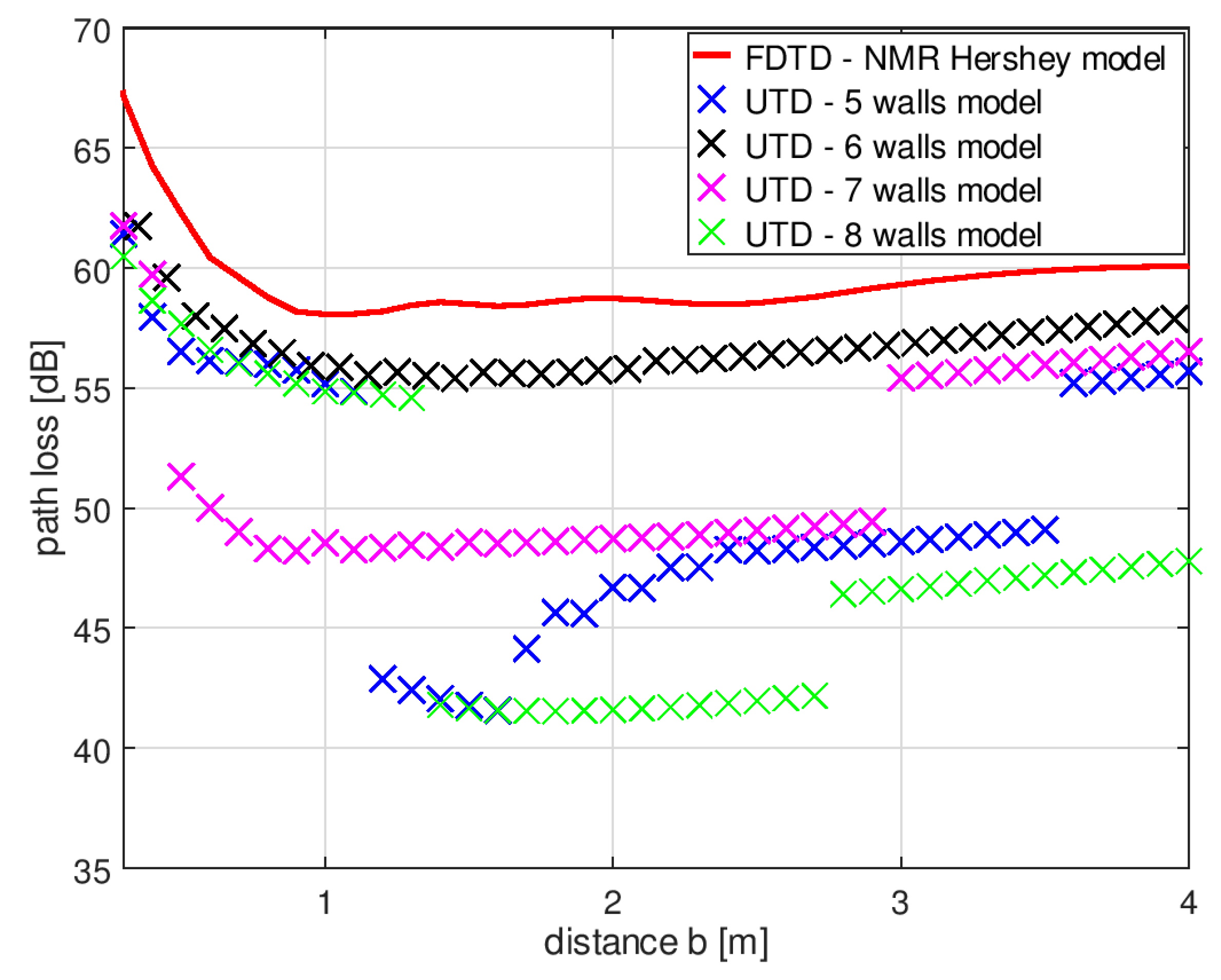
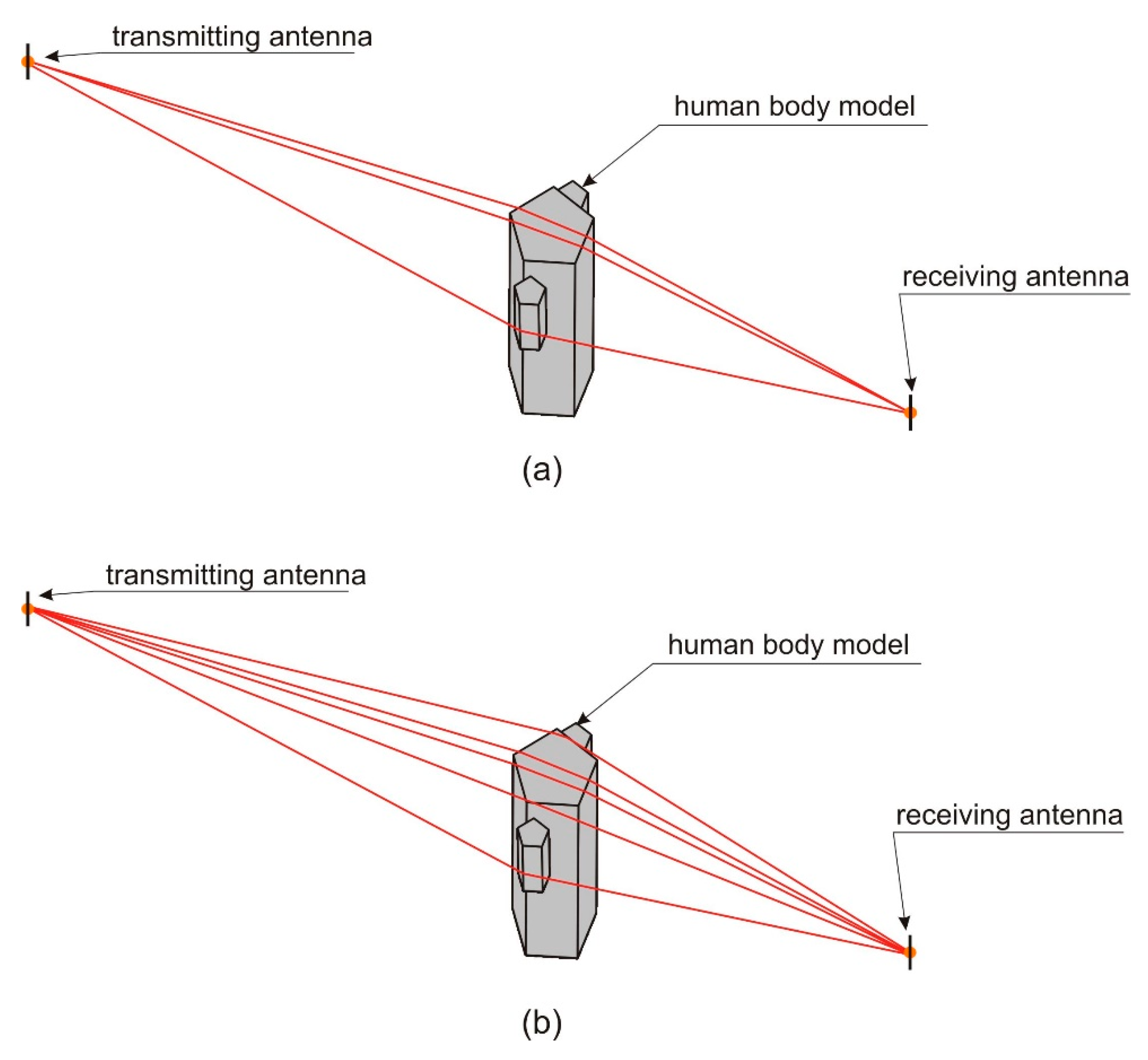
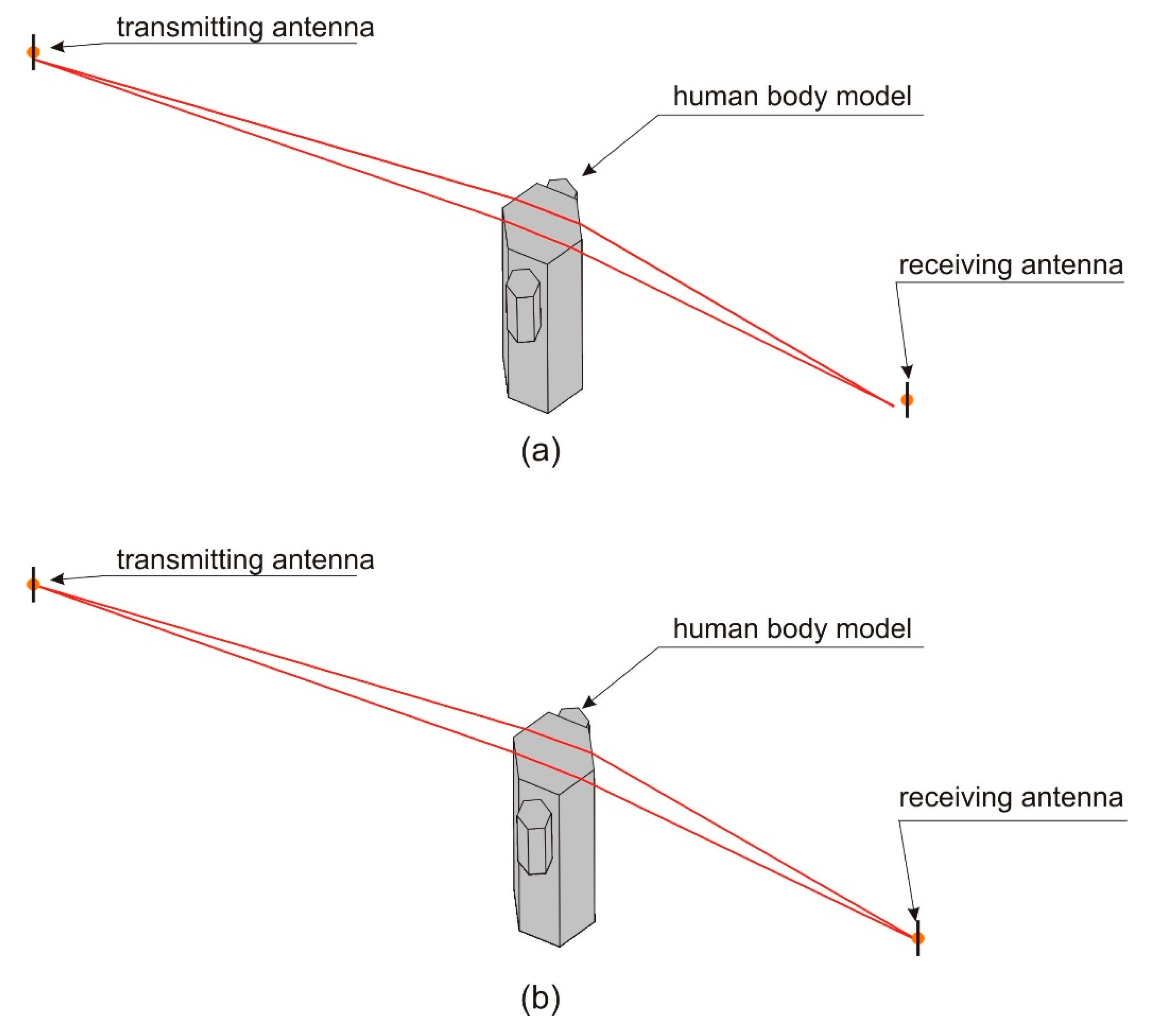

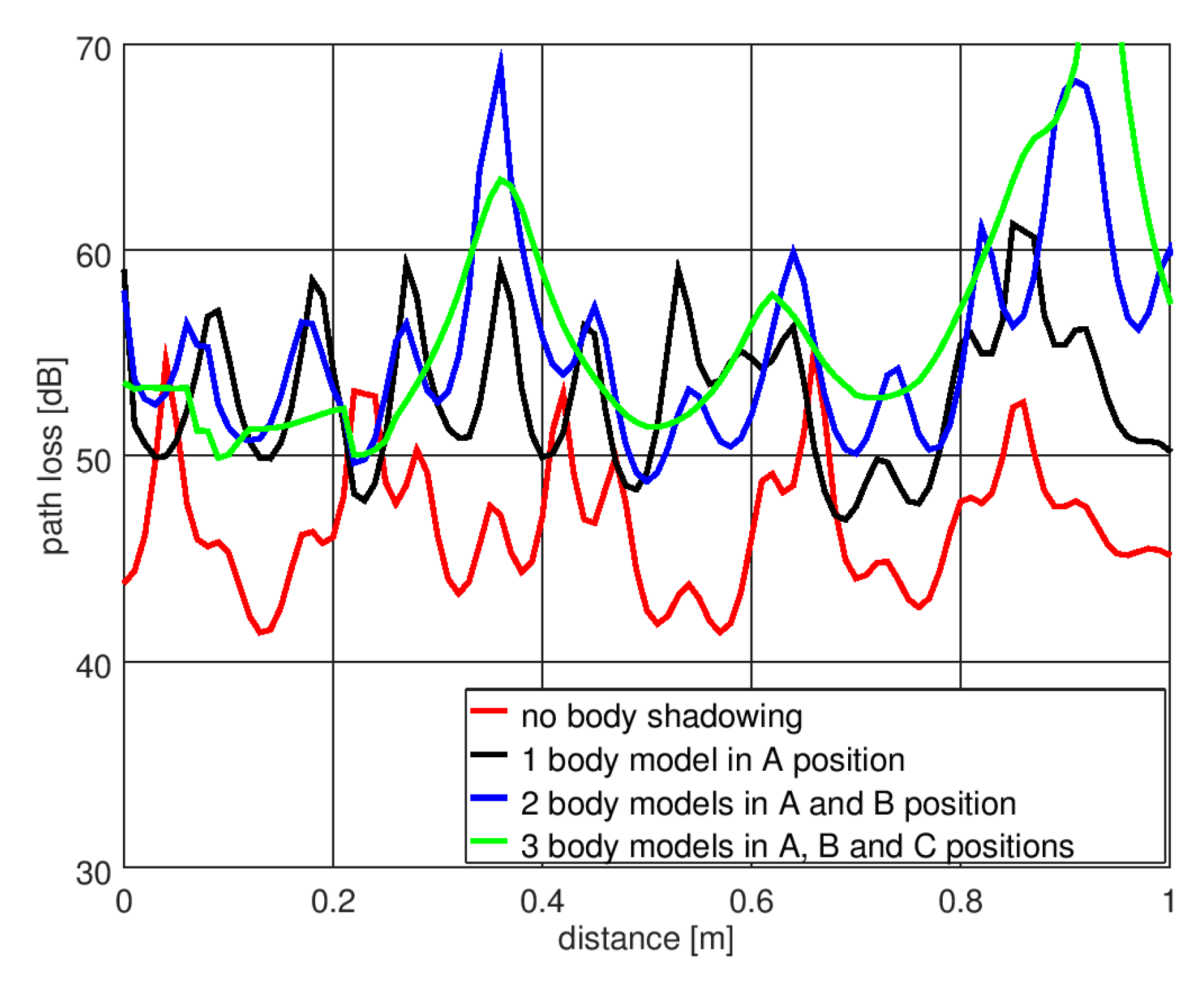

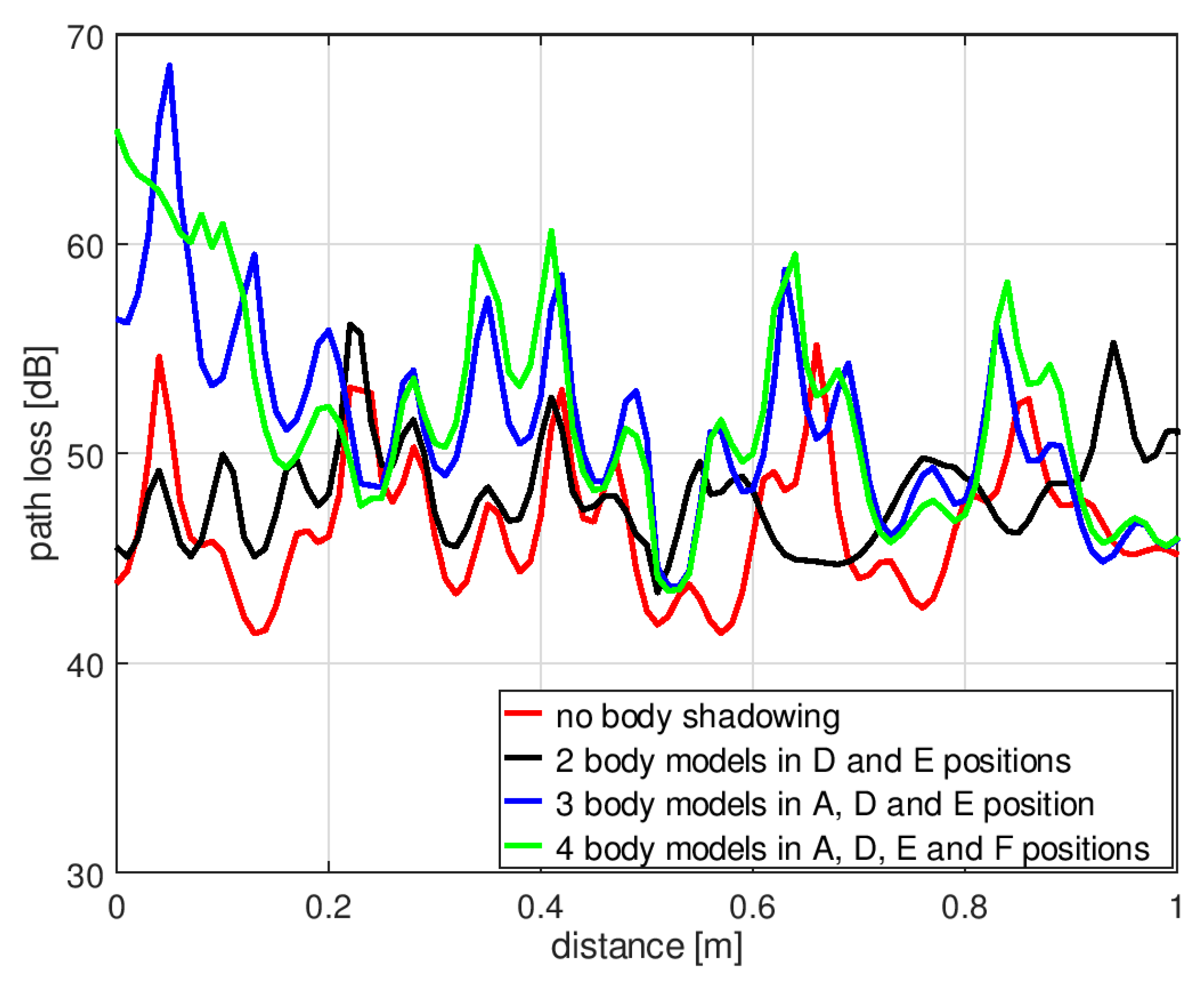
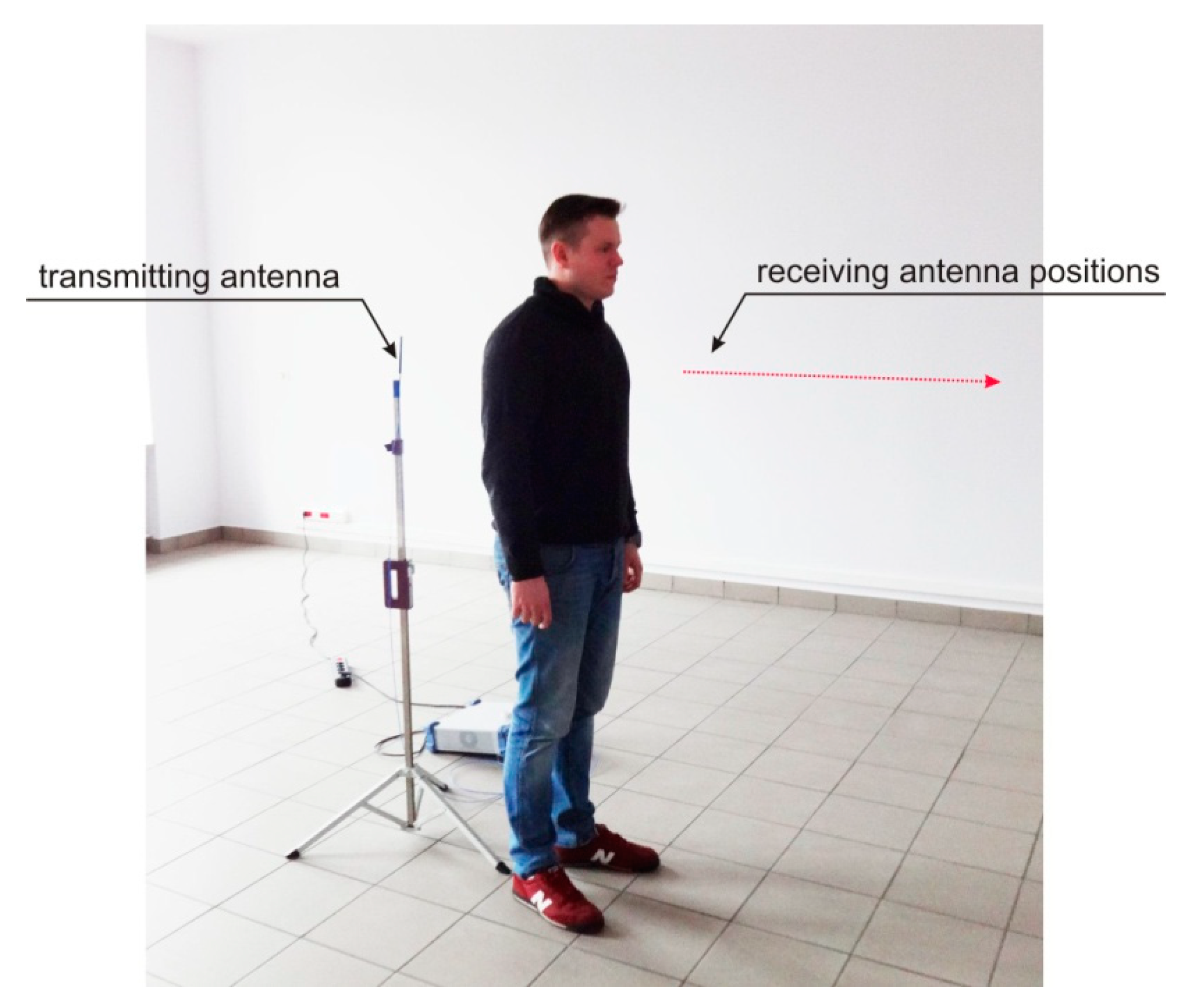
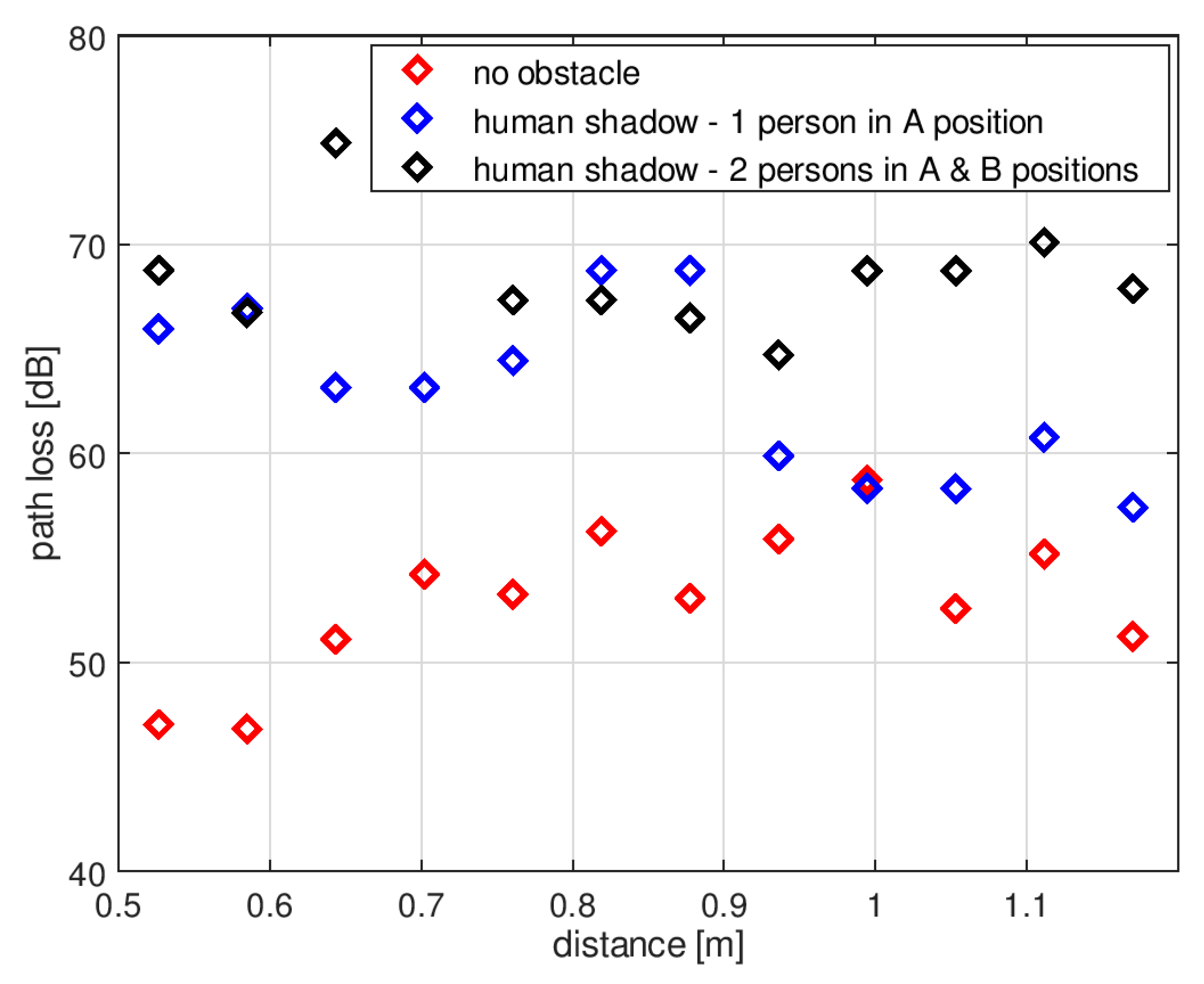
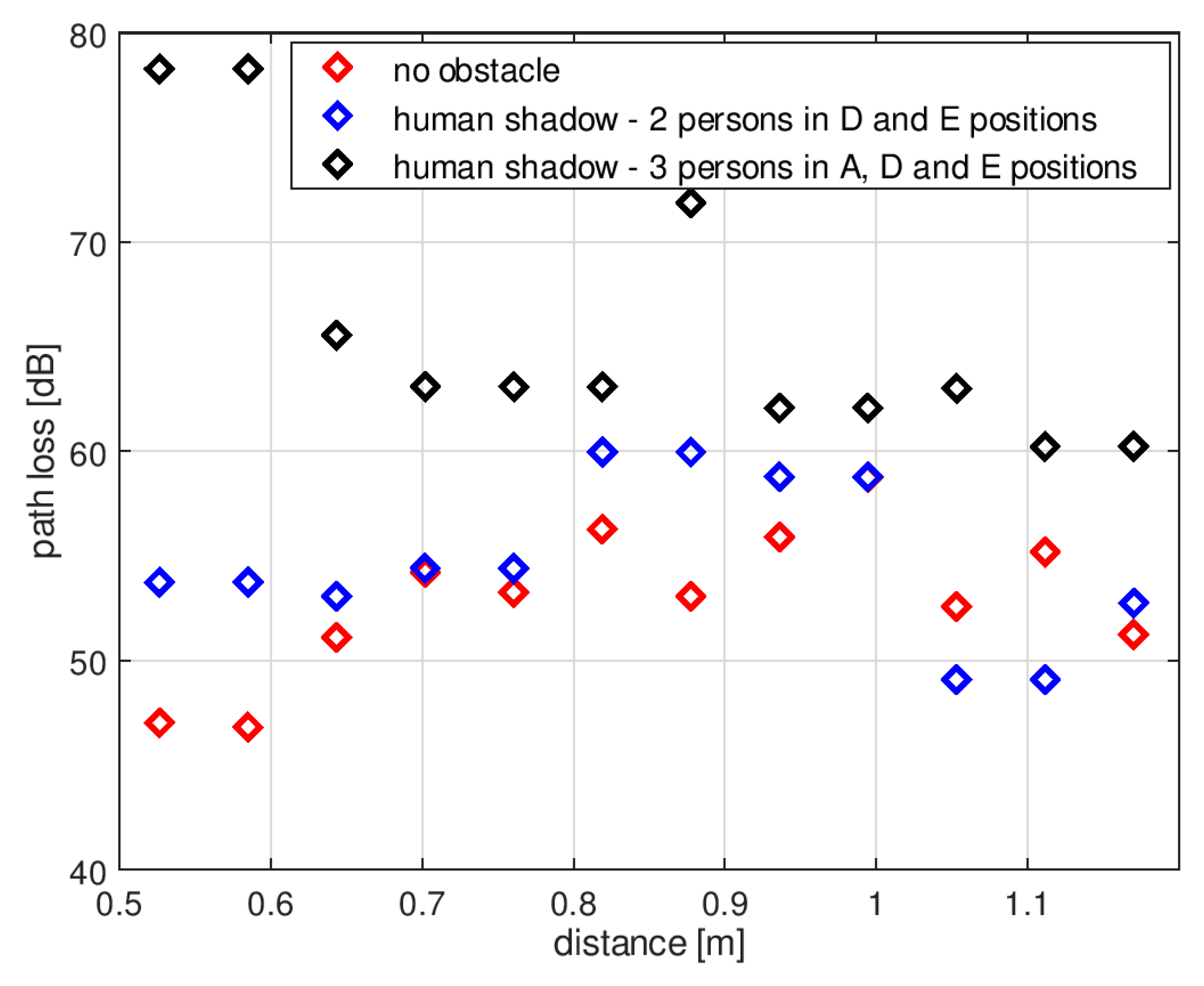
| Number of Sidewalls | Difference between Median Path Loss [dB] Obtained with UTD and FDTD Across Particular Distance Ranges | ||
|---|---|---|---|
| 0.5 m–1 m | 1 m–2 m | 2 m–4 m | |
| 5 | −2.7 | −12.6 | −8.3 |
| 6 | −1.9 | −1.7 | −2.3 |
| 7 | −11.6 | −9.2 | −4.1 |
| 8 | −3.2 | −13 | −13.7 |
© 2018 by the author. Licensee MDPI, Basel, Switzerland. This article is an open access article distributed under the terms and conditions of the Creative Commons Attribution (CC BY) license (http://creativecommons.org/licenses/by/4.0/).
Share and Cite
Januszkiewicz, Ł. Analysis of Human Body Shadowing Effect on Wireless Sensor Networks Operating in the 2.4 GHz Band. Sensors 2018, 18, 3412. https://doi.org/10.3390/s18103412
Januszkiewicz Ł. Analysis of Human Body Shadowing Effect on Wireless Sensor Networks Operating in the 2.4 GHz Band. Sensors. 2018; 18(10):3412. https://doi.org/10.3390/s18103412
Chicago/Turabian StyleJanuszkiewicz, Łukasz. 2018. "Analysis of Human Body Shadowing Effect on Wireless Sensor Networks Operating in the 2.4 GHz Band" Sensors 18, no. 10: 3412. https://doi.org/10.3390/s18103412
APA StyleJanuszkiewicz, Ł. (2018). Analysis of Human Body Shadowing Effect on Wireless Sensor Networks Operating in the 2.4 GHz Band. Sensors, 18(10), 3412. https://doi.org/10.3390/s18103412





